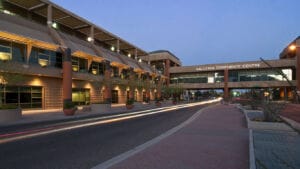Certain birds of prey are known for their incredible vision. Our very own Sonoran Desert dweller — Harris Hawk — not only registers objects at incredible speeds but also possesses acute vision of varying light waves. Much like the Harris Hawk, West Valley visionaries zeroed in — with incredible foresight — the potential for profound healthcare expansion throughout their region. And, to accommodate accelerated population growth within the West Valley, economic developers and city leaders have and continue to prepare the necessary infrastructure to house a healthcare nest befitting of the local communities’ diverse needs and wants.
“JLL’s recent Patient Trends survey points out that from the patient’s perspective, location and convenience are among the most important factors in choosing a healthcare provider or facility,” explains Mari Lederman, vice president and healthcare/medical office expert at the JLL Phoenix office.
READ ALSO: Loop 303 corridor becomes global center for development
The JLL report further demonstrates that “83% of respondents would pick a facility because it is located nearby, even if that facility is outdated, versus driving to a newer facility farther away.”
Home to 1.7 million residents and projected to capture more than 50% of the county’s future growth, the West Valley is making room for a variety of healthcare options for residents. And, in the process, the boom in healthcare activity throughout the region continues to attract more healthcare economic development and generate robust job opportunities.
Notes Katie McIntyre, vice president and healthcare/medical office expert at JLL Phoenix office, “Healthcare providers and systems need to be proactive in building their facilities near where the patients live and should be paying close attention to convenient access. Freeway accessibility is one key way for health systems to capture a wider tenant base, and the West Valley is well prepared for that, both with its existing infrastructure and the opportunity for growth along Loop 303 and the expansion of Loop 202.”
Pediatrics
As one of the fastest-growing regions in Arizona — and the nation — the West Valley continues to accumulate a wide variety of healthcare facilities and companies. This includes the arrival of multiple new Phoenix Children’s Hospital sites that President and CEO Robert L. Meyer describes “as one of the largest expansions in the history of the organization, providing the capacity for up to 150,000 visits annually.”
“While we have offered specialty and urgent care in this part of the metro for many years, it became clear that West Valley families needed more,” Meyer says. “The area has grown by leaps and bounds, increasing the demand for healthcare services.”
As a long-term fixture for children’s healthcare since its inception in 1983, Phoenix Children’s is widely recognized for its treatment of the most complex cases and offering services in more than 75 pediatric subspecialties, according to Meyer. And, nearly 40 years later, the organization has expanded its services dramatically.
“We’re a solution for healthy children, too, with general pediatrics, primary care, sports medicine, urgent care and other specialty services,” Meyer says. “The children who live in the community today — and those who will move to the West Valley in years to come — deserve to have access to world-class pediatric medical and behavioral healthcare, right in their own backyards.”
And as more backyards are built in the West Valley, the pediatric population is set to skyrocket, projected to grow at twice the national rate over the next five years, increasing to 500,000 in 2030 from 400,000 today, according to Meyer.
To accommodate all that West Valley and Greater Phoenix children will need, the new cohort of Phoenix Children’s Hospital facilities includes Phoenix Children’s Hospital-Arrowhead Campus, Southwest Freestanding Emergency Department Campus and Phoenix Children’s Sports Medicine Clinic in Avondale. Together, these campuses are projected to bring in 650 jobs and an estimated $200 million in economic investment.

Banner Health is planning construction for a new, comprehensive hospital and medical center in Buckeye.
Surgery and imaging
Phoenix Children’s Hospital isn’t the only health organization to set up shop in multiple locations throughout the West Valley. Apricus, a value-based healthcare company created by Arizona physicians, announced in Feb. 2021, plans to open two Apricus Health Surgery Centers — one in Avondale and the other in Surprise — set to open in mid-2022.
“With the population growth we have witnessed in the West Valley, patients simply need more choices in their healthcare,” says Chris Maione, senior vice president of ancillary services at Apricus Health. “Apricus demographics and network of primary care clinics warrant facilities that are convenient to this expanding patient population.”
The two surgery centers followed the fall 2021 opening of an Apricus Imaging Center at the AKOS Medical Campus in Avondale. The imaging center provides patients with state-of-the-art medical imaging services courtesy of advanced MRI, PET-CT, radiography, ultrasound and additional imaging technology. It also serves as an example of a growing trend within healthcare.
“We’re going to be doing several cath lab upgrades, and other types of imaging upgrades,” says Derek Contizano, project executive for SDB Contracting.
Adds Eric Hoffmann, senior project manager of healthcare construction for SDB Contracting, “There’s this pretty healthy ecosystem of investors who have nothing to do with healthcare — at least in their training or career — buying into different ambulatory surgery centers, medical imaging centers or radiation-oncology centers where they treat cancer.”
Contizano and Hoffmann note that these surgery and imaging centers are attractive to investors largely because they allow them to all own a piece of the health center, while not having to maintain the volume on their own.
“Instead of having one doctor run the office with his staff,” Hoffmann says, “you have multiple physicians, multiple staffs, multiple billing setups, multiple insurances — but by cohorting together — they can financially support the center and keep it busy.”
Micro-clusters and micro-hospitals
While large-scale projects, such as the recent Abrazo Health 27-acre land purchase for a medical campus (southwest corner of I-10 and Verrado Way) in Buckeye are making a mark out west, micro clusters and micro-hospitals are also securing a strong presence throughout the region.
“I have definitely noticed more free-standing ERs,” notes Sintra Hoffman, president and CEO of WESTMARC. “Dignity Health has several in the West Valley that provide care to residents in a hyper-local manner. Micro-hospitals are also trending strong. Arrowhead in Glendale and Bell Road/Grand Avenue in Surprise have attracted their own clusters of healthcare providers. Wickenburg also has a robust healthcare cluster which started with an exclusive niche in behavioral healthcare.”
Hoffman also points to the area north of I-10 from Banner Estrella Health in Phoenix, moving west through Avondale as a healthcare cluster hotspot, housing Copper Springs, AKOS, IMS and Phoenix Children’s Hospital — extending into Goodyear where Adalente, IMS, Abrazo and Cancer Treatment Centers of America reside. Then, onward into Buckeye, where Banner and Abrazo are accompanied by several additional healthcare providers.
“Hospitals and healthcare systems are looking strategically at how to make care more accessible throughout the Valley,” explains Brian Brown, Kitchell regional executive, “and that growth begets more, and so on. As healthcare facilities proliferate, so will the ancillary services these facilities render.”

Rehabilitation
More surgery centers, hospitals and micro-hospitals have led to an increase in demand for rehabilitation. But, that’s not the only reason there’s been a rise in rehab facility activity in the West Valley.
“There is a huge need for this type of bed space, especially since COVID,” McIntyre says. “Several rehabilitation hospitals have been announced recently in the West Valley, specifically in Avondale and Peoria. Our client, Reunion Hospitals, is under construction on a 40-bed facility in Peoria.”
Adds Hoffman, “ClearSky Rehabilitation Hospital is also planning a 30-bed facility along the West Valley’s healthcare corridor in Avondale.”
Behavioral and mental health
While many West Valley healthcare trends meet the specific needs of its growing population, some also mirror national trends. This includes a rise in need for behavioral and mental health services and resources.
In the fall of 2021, the American Psychological Association reported, “more than 8 in 10 (84%) psychologists who treat anxiety disorders said they have seen an increase in demand for anxiety treatment since the start of the pandemic.” An additional 72% of psychologists said they’ve seen an increase in patients with depression (compared with 60% in 2020).
“Outdated stigmas about mental health are diminishing and we’re seeing more patients seeking, or being referred for these services,” Hoffman says. “The pandemic has also impacted behavioral health by increasing overwhelmed healthcare workers as patients in this area. Copper Springs, Destiny Springs, Aurora and others are providing these services but the needs still outpace the existing care.”
Administrative support
Following the influx of patient-care facilities has, in-turn, resulted in an uptick of healthcare administrative support development activity.
“We’re seeing an increased need for healthcare administration/office space,” Hoffman affirms. “As healthcare providers expand acute care to serve the growing population, they now have to plan for separate administrative space.”
Brown agrees with Hoffman, saying that “more medical office buildings that house the primary practices for the physicians and support staff,” will be a requirement as healthcare widens its reach throughout the West Valley and beyond. “It’s about bringing care to the communities where and when they want it,” he says. “We anticipate strong growth in this area over the next decade.”
Education and workforce pipeline
Of course, you cannot have a conversation about healthcare momentum in the West Valley without mentioning its built-in education and workforce pipeline. As substantial healthcare employment demand increases, the West Valley has created a means of supplying the talent required to fulfill the growing need for skilled employees.
“A lot of the [existing talent] is going to age out at some point, so it’s important to ask: ‘where’s the next generation coming from that will maintain these very, very intricate and complex infrastructure systems?’” Contizano questions. “You see a lot of the nursing schools coming online, trying to promote that trade schools are back in flux to fill these needs.”
In addition to remote-accessible, online options, the West Valley has robust in-person, online and hybrid educational offerings catering to a wide range of healthcare focuses. Those seeking a career in healthcare have access to Franklin Pierce University in Goodyear, specializing in PA and PT programming; Midwestern University medical, vet and dental school (the only dental school in the state) in Glendale; Grand Canyon University’s nursing program; and several local community colleges with healthcare programs in partnership with Arizona State University, Northern Arizona University and University of Arizona. Add to this, a large number of private healthcare schools.
“We are fortunate to have over 25 education providers in this region with several focused on healthcare programming,” Hoffman says. “This helps the greater region by developing the healthcare workforce pipeline.”
And the workforce pipeline will continue to be an essential aspect of westward healthcare expansion for the foreseeable future.
“The Baby Boomer generation continues to age and Millennials have started to have families. Add to that Phoenix’s exploding population and you can see why demand for Valley healthcare services will only continue to increase, bringing jobs and economic stimulus with it,” Lederman says. “Based on JLL’s Patient Survey, that growth actually can be very localized (versus regional) since 40% of respondents say they drive less than 15 minutes to receive care.”
In closing, Brown adds, “There are higher-income professionals including physicians, nurse practitioners, physician assistants, nurses, therapists, dentists and pharmacists who will live in these communities and patronize businesses in the area. There are also other healthcare workers who are not in direct patient contact and also support the industry and economic growth of the region.”




